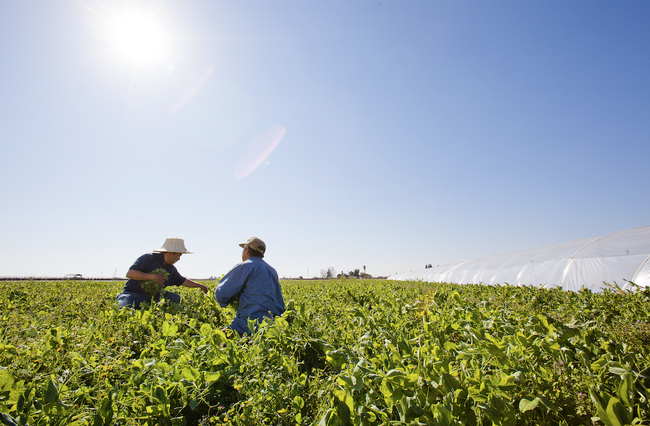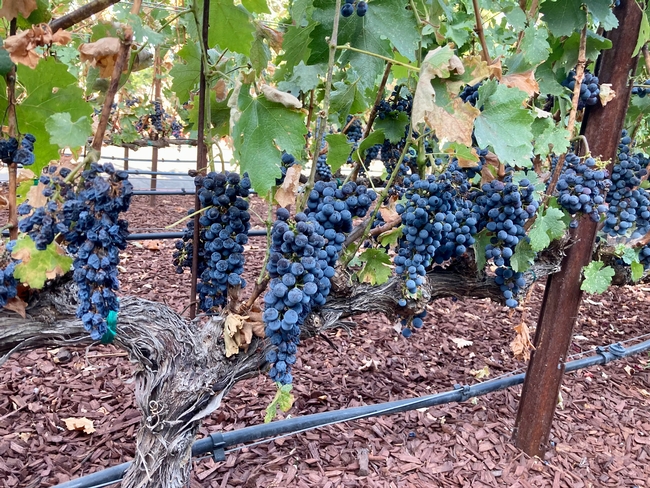Posts Tagged: change
Extreme weather accelerates nitrate pollution in groundwater
Extreme weather spurred by climate change, including droughts and heavy rains, may increase the risk of nitrates from fertilizers ending up in groundwater, according to a recent study from researchers at the University of California, Davis. The study found heavy rains after a drought caused nitrates to seep 33 feet under farm fields in as little as 10 days. The study was published in Water Resources Research.
“The conventional wisdom was that it could take several weeks to years for nitrates to move from the crop root zones to reach groundwater,” said corresponding author Isaya Kisekka, a professor in the Departments of Land, Air and Water Resources and Biological and Agricultural Engineering. “We found these extreme events, such as California's atmospheric rivers, are going to move nitrate more quickly.”
In this study, different methods were used to measure how much nitrate, a component of nitrogen fertilizer, was seeping down through the soil in a tomato and cucumber crop near Esparto, California. Scientists conducted their research from 2021 until 2023 when California was experiencing periods of drought followed by atmospheric rivers. They measured nitrate during both the growing seasons and the rainy seasons.
Drought can leave more nitrogen in soil
Previous studies have shown about 40% of nitrogen fertilizer used for vegetables isn't absorbed by the plants but remains in the soil. During droughts, crops don't use nitrogen efficiently, leading to excess nitrogen in the soil. This study found that if a drought is then followed by heavy rainfall, that sudden burst of water causes nitrate to seep in groundwater more quickly. The nitrate concentration in the shallow groundwater exceeded the U.S. Environmental Protection Agency maximum contaminant level of 10 milligrams per liter for drinking water.
“In California, we often say we swing between droughts and floods,” said Kisekka. “These extreme events that come with climate change are going to make the risk of these chemicals ending up in our drinking water much more severe.”
Groundwater is the primary source of drinking water for most of California's Central Valley. In some regions, such as the Tulare Lake Basin, nearly one-third of drinking and irrigation wells exceed the EPA's safe nitrate level. High nitrate levels in drinking water can increase health risks, especially for young children. It may also increase the risk of colorectal cancer.
Need for real-time soil nitrate monitoring
Central Valley farmers are required to report to the Regional Water Board how much nitrogen they applied to their field and how much was removed as part of the crop's yield. The study compared different ways of monitoring when nitrate from fertilizers seep into groundwater. Kisekka said the results highlight the need for affordable, real-time soil nitrate monitoring tools to help farmers manage fertilizer use efficiently.
By using conservation practices that limit leftover nitrates in the crop's root zone after harvest, farmers can help reduce nitrate contamination in groundwater.
This study's data will also help improve a model called SWAT, which is used to track nitrate seepage into groundwater across California's Central Valley. This effort is part of the Central Valley Water Board's program to regulate irrigated farmlands.
Other UC Davis authors include Iael Raij Hoffman, Thomas Harter and Helen Dahlke.
The study was supported by the USDA Natural Resource Conservation Service through its Conservation Effects Assessment Project. The national project is designed to assess the effectiveness of conservation practices across different watersheds. The study also had support from the USDA National Institute of Food and Agriculture.
White House Summit explores impact of extreme heat, ways to adapt
UC ANR Small Farms Network supports small-scale and underserved farmers impacted by extreme heat
Ruth Dahlquist-Willard, interim director for the UC Sustainable Agriculture Research and Education Program, joined more than 100 participants from across the country at the first-ever White House Summit on Extreme Heat. Community representatives and practitioners met with federal agency representatives and Biden Administration officials to discuss successful locally tailored, community-driven practices to adapt to extreme heat as well as available federal resources.
According to the National Oceanic and Atmospheric Administration or NOAA, summer 2024 was California's warmest summer on record. As California's climate is changing, episodes of extreme heat are becoming more common, leading to substantial health, economic and ecosystem impacts.
In the agricultural sector, extreme heat events can cause heat illness in farmworkers, crop losses and changes in pest pressure. California crop losses due to drought, wildfire and heat were estimated at $239 million in 2023.
Disaster relief funds are available to help growers recover from lost production due to extreme heat. Since 2021, the UC ANR Small Farms Network has connected small-scale farmers with over $5.8 million in direct-to-producer relief funds for losses related to drought, flooding and other extreme weather events.
To further support small-scale farmers in adapting to the changing climate, Dahlquist-Willard and the Small Farms Network are evaluating how the extreme heat of summer 2024 impacted farmers. Farmers reported anecdotal observations that included:
- Shifting work hours to cooler parts of the day
- Closing farm stands and farmers markets due to extreme heat
- Crops ripening more quickly than expected, impacting harvesting and packing schedules
- Poor fruit set due to extremely high temperatures
The team is working to determine what damage symptoms on small-acreage California specialty crops can be attributed to extreme heat based on scientific literature and assessments from UC ANR colleagues. Understanding the impact of extreme heat on the farming community can help inform research and policy, ultimately equipping farmers with strategies to adapt to extreme heat events.
“It was inspiring to meet with leaders from around the nation who are working to support communities impacted by extreme heat and learn about the creative solutions they are implementing,” said Dahlquist-Willard. “The challenges faced by these communities make it all the more important to continue to work against climate change by reducing greenhouse gas emissions, as well as to develop new methods and resources to mitigate the effects of extreme heat and other climate impacts.”
The Extreme Heat Summit highlighted the Biden-Harris Administration's investments in climate reliance and put forth an Extreme Heat Call to Action calling upon public and private sectors to prepare for future extreme heat events. Communities and governments interested in participating are asked to use all available tools to protect people from extreme heat. Approaches and tools which could be used to protect people and resources from extreme heat are highlighted in the U.S. Climate Resilience Toolkit and the National Heat Strategy. Submissions for the Call to Action will be accepted through Nov. 1, 2024.
Further reading:
Heat Illness Prevention, UC Davis Western Center for Agricultural Health and Safety
Pathak et al., 2018. Climate Change Trends and Impacts on California Agriculture: A Detailed Review
UC's New Climate Action Goals: Frequently Asked Questions
Bumble Bees: Feeling Impact of Climate Change
We remember the reaction of Robbin Thorp (1933-2019), UC Davis distinguished emeritus professor of entomology and an international authority on bumble bees, when he spotted a lone Western bumble bee, Bombus occidentalis, on Aug. 15,...
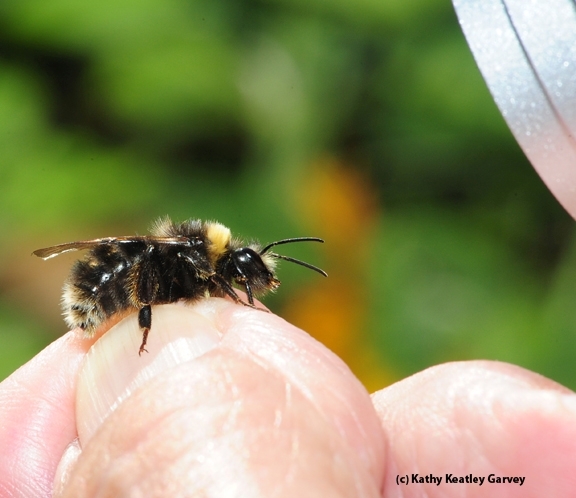
UC Davis research shows that rising temperatures are particularly alarming to some bumble bee species, including the Western bumble bee, Bombus occidentalis. This one was located on Aug. 15, 2012 in the Mt. Shasta area. (Photo by Kathy Keatley Garvey)
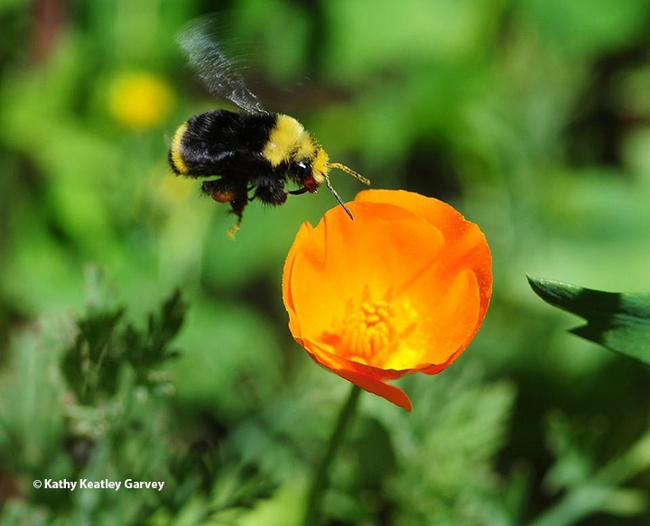
UC Davis researchers found that one of "the winners" in their climate change study is the yellow-faced bumble bee, Bombus vosnesenskii, shown here heading for a California golden poppy. (Photo by Kathy Keatley Garvey)
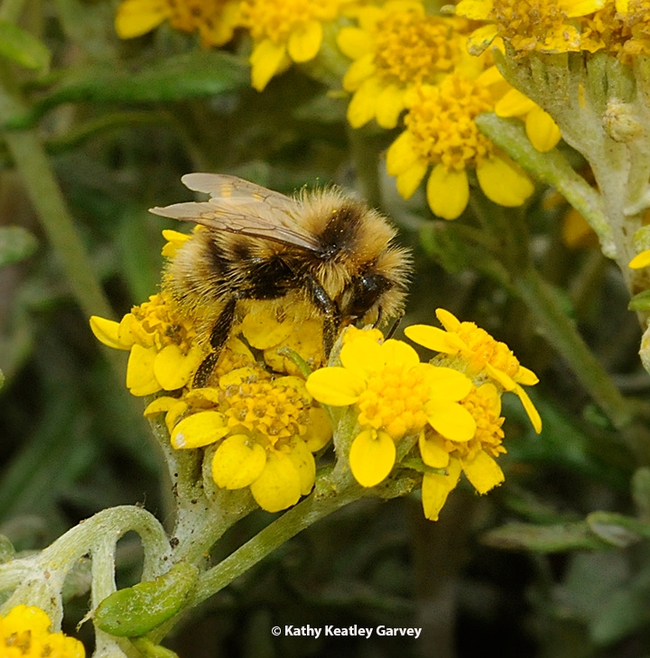
A male bumble bee, Bombus bifarius, nectaring on coastal goldfield, Lasthenia minor, at Bodega Bay. A UC Davis study shows that the rising temperatures are particularly alarming to a number of species, including this one. (Photo by Kathy Keatley Garvey)
Paper highlights how climate change challenges, transforms agriculture
As the climate continues to change, the risks to farming are only going to increase.
That's the key takeaway from a recent paper published by a team that included UC Merced and UC Agriculture and Natural Resources researchers. The paper dives into what those challenges are, how farmers are working to address them and what should come next.
"Climate Smart Agriculture: Assessing Needs and Perceptions of California's Farmers" was first authored by Samuel Ikendi, academic coordinator, with Tapan Pathak, UC Cooperative Extension climate adaptation in agriculture specialist, as a corresponding author. Both are based at UC Merced. Pathak is also a project director of National Institute of Food and Agriculture-funded project "Multifaceted Pathways to Climate-Smart Agriculture through Participator Program Development and Delivery," which supported this study. The study appeared in the open access journal Frontiers in Sustainable Food Systems.
The needs assessment was designed to understand farmers' perceptions and experiences with climate change exposures; the risk management practices they currently use; and what tools and resources would assist them in making strategic decisions.
Of the farmers surveyed, roughly two-thirds agree climate change is occurring and requires action. Even more said they are interested in learning more about the impacts of climate change on the agricultural industry. Most respondents said they experience greater climate change impacts on their farms today compared with 10 years ago.
Farmers were very concerned with water-related issues, with those in the San Joaquin Valley, Central Coast and Inland Empire areas particularly worried about a reduction in the availability of groundwater. Increased drought severity was a very significant concern among farmers in the Inland Empire, Central Coast and Southern regions. Farmers in the North Coast and Southern regions were concerned about increased damage to crops due to wildfire.
Closely related were temperature-related issues, including crop damage due to extreme heat.
Those who farm vegetables were more concerned about water availability for irrigation, while fruit farmers were more concerned about increased crop/water stress and increased crop damage due to extreme heat.
Many respondents said they are implementing climate adaptation practices including managing water resources, maintaining soil health and making more use of renewable energy sources. They are seeking insurance and government help to pay for these adaptations and increase their agricultural resilience, the researchers wrote.
The farmers expressed interest in learning more about measures they might take to mitigate climate change. But they cited significant barriers to this work, including government regulations, high implementation cost, labor access/cost, access to water and the availability of money to pay for it.
"Climate change is significantly altering California's highly diverse agricultural landscape, posing challenges such as increased water stress, heat stress, and shifting growing seasons," Pathak said. "Climate-smart agriculture practices can alleviate some of those stresses."
But, he said, research and UC Cooperative Extension efforts only have value if they lead to enhanced climate-informed decision-making at the local level.
"Assessing their level of knowledge, perception and needs will help in tailoring research and extension activities that are most relevant to farmers on the ground," Pathak said. "Results from this study could also provide important policy insights on financial incentives and technical assistance."
Lawn-pocalypse! Surviving Drought
Ah, summer! The season of sunburns, pool parties, and… lawn droughts. If your once lush, green carpet now looks like a crunchy brown doormat, you're not alone. Let's dive into why your yard is staging a dramatic death scene and what you can do to...

Bermuda grass and weeds overtaking drought stressed turf grass.


